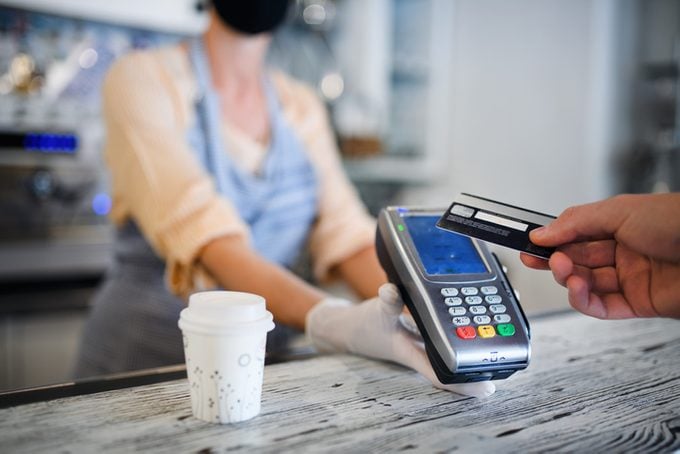What Is Tipflation? What You Should Know About the Increase in Tipping
Updated: Feb. 08, 2023

Digital payments on touchscreens are leading to tipflation, but do we have to tip everytime?
It’s customary to tip your server when dining at a restaurant, your hairstylist at the salon when getting a haircut, or the food delivery person when ordering dinner. Internationally, tipping etiquette varies by country, but here in the United States, we’re used to tipping for a handful of services. Lately, this handful of tipping situations has become more like carrying an overstuffed tote bag. Often called tipflation, we’re being asked to tip on transactions and services that are less traditional.
What Is Tipflation?
We’re often left with a screen that asks if we’d like to leave a tip when doing things such as paying for a carwash or picking up a premade sandwich—sometimes for a service that didn’t even involve a human. Donate to a fundraiser on GoFundMe and below your dollar donation, the site asks if you’d like to tip the GoFundMe service.
Similar to how the pandemic changed tipping etiquette, the way we pay for many things has also changed. The rise of contactless digital payments took off as a safer and easier way to pay, avoiding most face-to-face transactions. Diane Gottsman, a national etiquette expert and founder of the Proctor School of Texas, says the digital payment systems are just like the tip jar. “The apps make it easy for those who don’t use cash or need help calculating a percentage, however, it also may put pressure on the customer buying a cup of coffee or deli sandwich,” she said.
Digital payments asking for a tip can either be a percentage of the total purchase price or a set dollar amount. Grab a coffee to-go and you might see a screen prompting $1, $2, $3 or a “no tip” option. Gottsman mentions that while tipping is always considered a nice gesture, there are certain boundaries. “For a $4 cup of coffee, it’s unreasonable to leave a $4 tip,” she says.
Though there have never been set rules for how much to tip, most people follow general guidelines. According to a Discover survey of 999 Americans, 20% is the average tip in the U.S. for perfect service.
Why Tipflation Is Sparking Some Backlash
Tipping on more transactions isn’t sitting well with everyone, though. The U.S. Bureau of Labor Statistics says the consumer price index for food saw a 10% increase between December 2021 and December 2022. With costs of goods and services already higher than ever because of inflation, shelling out extra money for a tip isn’t part of everyone’s budget.
We’re all accustomed to tipping for a sit-down dinner, but tipping has seeped into more transactions than ever—and that includes when we barely have any interaction with a person. Are we supposed to tip an electronic screen or a payment system when we had no interaction with a human?
Do I Have to Tip When I See a Digital Tipping Screen?

There’s no hard and fast tipping etiquette when it comes to tipping on a digital screen. “There is not a one-size-fits-all answer to using the tip app. The criteria should depend on the effort, the interaction and your budget,” Gottsman says.
Gottsman says customers shouldn’t feel pressure to tip on every transaction. “It is always nice to show gratitude and generosity by leaving a tip when possible, but a customer should not feel pressured or overwhelmed by the little piece of technology looking them in the face,” she explained.
If you’re feeling awkward about selecting the “no tip” button, Gottsman recommends preparing some small cash beforehand to drop in the tip jar, or paying with cash and leaving the extra change.
“For a quick exchange over the counter, where there was very little effort involved, a tip is optional. Feel free to leave your extra change, $1 or $2 or customize your tip,” Gottsman suggested.
It’s always worth remembering that leaving gratuity is a way to show your appreciation for good service. If the transaction doesn’t involve a service, it might not warrant a financial reward.
Sources:
- Diane Gottsman, etiquette expert and founder of The Protocol School of Texas
- Discover Card Smarts: What is the Average Tip in America?
- U.S. Bureau of Labor Statistics: Consumer Price Index





















